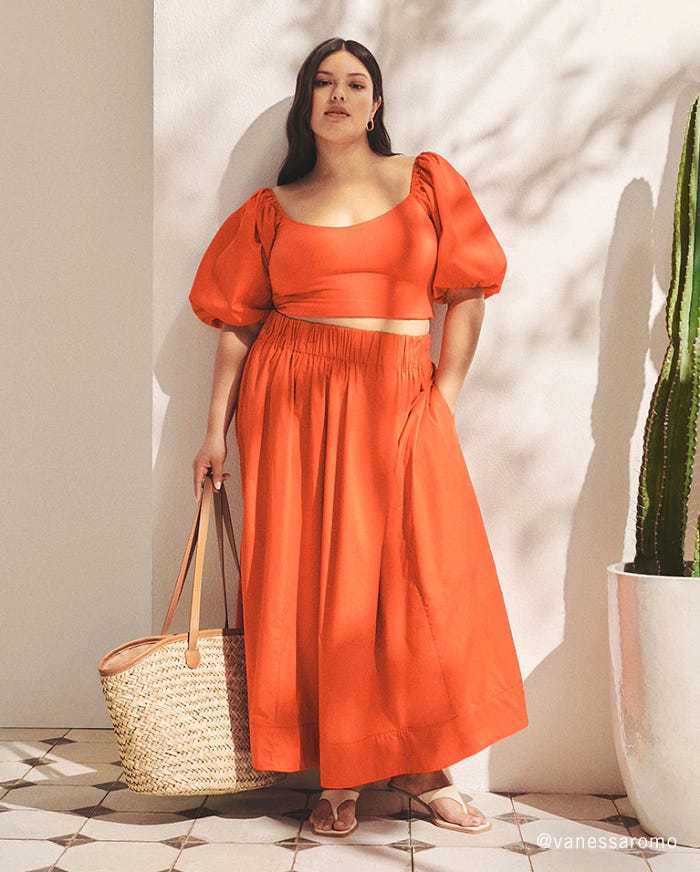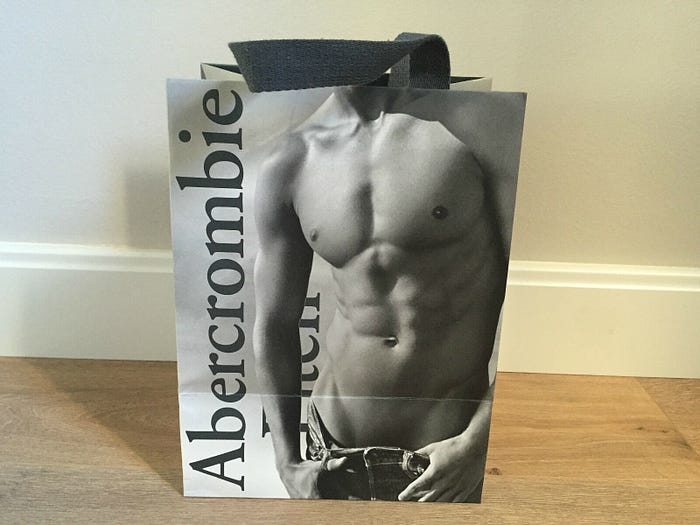

On Beauty: White Hot, White Noise, And Are Beauty Standards Really Better Now?
source link: https://rosalynmorris.medium.com/on-beauty-white-hot-white-noise-and-are-beauty-standards-really-better-now-ea0f23e5bb00
Go to the source link to view the article. You can view the picture content, updated content and better typesetting reading experience. If the link is broken, please click the button below to view the snapshot at that time.

On Beauty: White Hot, White Noise, And Are Beauty Standards Really Better Now?
Photo by Jessica Felicio on Unsplash
So, I recently watched the Netflix documentary, White Hot. It’s about mall retail chain, Abercrombie & Fitch, and it’s deplorable hiring practices back in the early 2000’s to around 2013.
In the end, the store had to atone for its hiring practices, of only hiring the young, white, and attractive, and the provocative images it used to sell its clothes by now offering larger sizes and putting images like this, and other more wholesome ones, on its website…

from Abercrombie & Fitch website
Abercrombie & Fitch used to be known for their ads, in black and white, that showed naked and half-naked bodies, in provocative poses.

They also had to pay millions in class-action lawsuits.
Then CEO Mike Jeffries operated the store by this motto, and I quote: “In every school there are the cool and popular kids, and then there are the not-so-cool kids. Candidly, we go after the cool kids. We go after the attractive all-American kid with a great attitude and a lot of friends. A lot of people don’t belong (in our clothes), and they can’t belong. Are we exclusionary? Absolutely.”
By all-American, he meant white, thin, and traditionally good looking with symmetrical features. There was even a book with pictures of people that let stores know what to look for, and what not to look for.
The store and its practices were racist and elitist, and decidedly so…
Even though Jeffries made these comments in 2006, there wasn’t public backlash until 2013 — seven years later. This is reflective of a shift in what’s culturally acceptable and what’s not.
In the past, it was “cool” to be exclusive, and society has shifted to being more accepting of people and their differences, at least on paper. Whereas whiteness and thinness used to be the “norm,” people have been fighting in the last decade, or so, to be inclusive of all people regardless of size, shape, or skin color. The Abercrombie & Fitch way of thinking is no longer acceptable, at least not in a mainstream way, and hasn’t been for some time.
Rihanna’s Fenty makeup line has made her a billionaire because it has 50 shades…from the darkest to the lightest.
Most retail stores have expanded their sizing and it’s now normal to see people of all shapes and colors, who don’t look like supermodels, in advertising.
This documentary got me thinking about America’s obsession with beauty, and of course, its damaging effects on the youth.
Abercrombie & Fitch was a store for kids: tweens, teens, and college-age. Jeffries battered the self-esteem and self-image of a generation of young people, and he wasn’t the only one.
So much of what’s held up as beauty, when you are young, and the opposite, can be detrimental to your self-esteem.
It can take decades to unlearn, and some people, unfortunately, never do.
Me, personally, I never shopped at Abercrombie & Fitch, nor did I want to. I can’t recall ever stepping a foot in that store, and I spent a disproportionate time of my youth at the mall. I was aware of the store, as I passed it all the time, but it was pretty clear that it was very white. Also, it wasn’t my style. I didn’t frequent Aeropostale, American Eagle, or Hollister, for the same reasons, even though they didn’t use the same hiring practices nor did they treat customers who didn’t belong poorly.
However, as a Black teenager, it was clear what the idea of beauty was. It was ubiquitous. This idea came from television, movies, and most frequently, rap videos and lyrics.
For a woman, it was all about being a redbone aka light-skinned. Even better if you had long hair or were biracial.
It wasn’t only Black media and rappers who did this. The idea was reinforced by white media as well. If you looked at any music video, TV show, or movie, the “honey” was a light-skinned Black woman. Always.
When I was younger, while I didn’t shop at Abercrombie & Fitch, I did listen to music by men who made disparaging comments about Black women, while uplifting certain Black women, and also non-Black women. I don’t do that anymore. I don’t listen to, or watch anything produced by, men like Lil Wayne, 50 Cent, Kanye West, TI, Chris Brown, and others. When they come on the radio, I turn them off. If I hear they’ve said anything, they are cancelled in my book.
I’ve been called “sensitive,” but I care about the self-esteem of young Black girls who are living daily in a world that’s telling them they’re not good enough, or that they’ll never be attractive, because it has long term effects. I won’t give a penny of my money to men who make lyrics like “my girl makes your girl look like Precious.” Especially not when he’s clearly talking about the average Black woman. Also, Gabourey Sidibe is beautiful, by the way.
I used to feel alone in calling out these things, but I’m not anymore, and that’s another reason why I love Gen-Z so much. They call out everything. So this led me to the question…
Are beauty standards better today??
I did an informal poll on Twitter. I asked the question, and the overwhelming majority of respondents said, NO, beauty standards are not better now than they were twenty, fifteen, or ten years ago. In fact, they’re worse…
Here’s why…
Beauty standards are more unrealistic than they used to be…
Thanks to makeup, lacefronts, weaves, wigs, extensions, false eyelashes, contouring, etc. beauty standards in 2022 are unreal. The natural look is long gone, and a lot of women and teenage girls want to be glamorous by any means necessary. This means wearing false eyelashes daily and wearing three coats of makeup everytime they leave the house. Fake nails are also the norm and online boutiques, and cheap online shopping, make it possible to mimic the looks of “Instagram models and celebrities” on a daily basis. Young women are consumed with their appearance.
Altering your appearance is the norm…
Celebrities like the Kardashian/Jenner klan have literally changed their entire faces and bodies, and young women see this and want to emulate it. Kim Kardashian made a body, while her younger sisters, Khloe Kardashian and Kylie Jenner, built their faces and bodies. You only have to go to YouTube to see thousands of videos with women and teenage girls showing you how to emulate this “plastic” look. You can also find videos of women walking you through their BBL (Brazilian Butt Lift) procedures, where a plastic surgeon sucks fat from different places in your body, and then transfers it to your butt. Women are literally dying from going to unlicensed “practitioners” or third-world countries to get these unnecessary procedures done for a cheap price.
Social media and photoshop…
Social media is filled with images of women who use photoshop, and who also all look alike, to sell products like tummy teas, waist trainers, and diet products. Some of these women are reality TV stars. All you have to do is watch their tv shows, or catch them walking down the street, to know that they do not look like these heavily altered images. Yet, women and young girls, see these images and feel inadequate because they don’t look that way. Nobody looks that way.
As far as young Black women and girls are concerned, they’re still getting the short end of the stick of what’s considered beautiful. While light skin is still in, there’s now blackfishing. That means a light skinned Black woman is no longer the standard. Now it’s a non-Black woman who wears makeup and gets surgery to emulate a Black woman. Black women are still considered the most attractive comparable to how close they match Eurocentric beauty standards. Skin bleaching is also prevalent.
Alas, the more things change, the more they stay the same.
What I wished young people, and some adults, would understand, is that at the end of the day all of this is just white noise.
You do not have to look like everyone else, and your value is not based on your appearance.
You don’t have to be deemed attractive by any outside factor.
Love yourself for who you are, the way you are.
If someone doesn’t deem you attractive enough to be a friend, romantic partner, or even employee, that is THEIR problem. It’s not yours, and you do not have to internalize their values. That’s how you become bitter or resentful, and that’s also the point. Jeffries could have catered to a certain demographic, but that wasn’t enough, he had to put others down in the process. He wanted young people to loathe their appearance and feel unworthy. How detestable is that?
It’s up to you to see the beauty in yourself…
That’s not a cliche.
Also, in the infamous words of Judge Judy…
BEAUTY FADES, BUT DUMB IS FOREVER…
Recommend
-
 27
27
App to play soothing white noiseMuse is an app that will drown out the noise of the street and allow you to concentrate on the work at hand, increasing your productivity.
-
 6
6
Creator & Artist Stories What Hyram really thinks about clean beauty
-
 9
9
How Rihanna Changed Beauty Standards and Conquered the Business WorldFans of Rihanna’s music have been eagerly waiting her ninth album, affectionately called “R9.” It has been a long time since she released new music: over...
-
 8
8
The 6 Best White Noise Apps for Android to Help You Sleep Better By Pranoti Panchwagh Published 14 hours ago Improve your sl...
-
 8
8
Filed under: Google changed the Assistant’s white noise sound, and many aren’t happy about it Somebody has al...
-
 1
1
Are you a robot? Bloomberg Need help? Contact us We've detected unusual activity from your c...
-
 9
9
Birchtree By Matt Birchler I've been writing here since 2010! Back when personal blogs were all the rage. Kids, a...
-
 11
11
beautyVirtual body-shaming: Why the metaverse won't fix our IRL beauty standardsPublished 29th September 2022
-
 6
6
How white noise took over the music industry – and put musicians out of pocket Songs made up of ambient noise have exploded on YouTube and Spotify, with creators making a killing. But where does this leave real music?
-
 7
7
Home ...
About Joyk
Aggregate valuable and interesting links.
Joyk means Joy of geeK